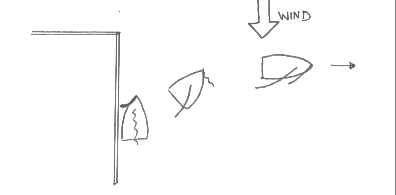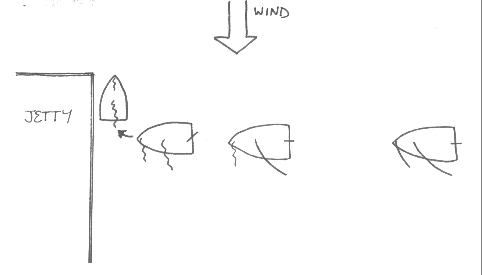RYA Seamanship Skills
Fisherman's Bend
Used for securing a rope to a ring when you want to leave it perminantly (tying a warp onto an anchor), its very simular to a round turn and two half hitches but you take the 1st half hitch through the round turns.

Sheet Bend
A sheet bend is used for tying to sheets (ropes) together of unequal diameters, which you later wish to get undone.

Heat Sealing and whipping
Both heat sealing and whipping are methods of stopping the end of a rope from unraveling. Modern rope such as you will find on any sailing dinghy are made out of various types of Nylon / Plastic. When heated this melts just as you would expect plastic to do.
Heat sealing is best done by heating up the blade of a knife and using the hot blade to slice through the rope. An alternative is to carefully cut the rope with a cold knife and melt the end with a cigerete lighter. You should take care not to get any of the hot plastic on your skin because it sticks and burns and the fumes it creates are toxic.
Whipping is a more traditional method of sealing the ends of ropes and works also on non plastic ropes. You will need a length of whipping twine, this should be long enough to wind round the rope to make a whipping approximatly 3 times the diameter of the rope in length.

Back to the contents
Leaving and returning to a Jetty
In your Level 2 course you learnt to leave and return to a jetty, landing and leaving from a windward shore or a place where you started or ended facing the boat into the wind.
Leaving - 
Returning - 
It isn't always possible to land or launch from the perfect windward shore so we need to know what to do if we have to use a Lee shore (one with the wind blowing onto it).
The problem we have with a lee shore as opposed to a windward one is how to stop the boat. If we let the sails out as we did for a windward landing the wind is now behind us so we will go even faster. So we are going to have to find another way of depowering the sails.There are two different methods depending on if you are in a double or single hander.
In a double hander boat we take down the main sail. This is done by 1 stopping your boat a fair distance upwind from where you wish to land and turning it into the wind, 2 lowering the main sail and 3 sailing in under the jib alone.4 When the boat is a few feet off the shore in shallow water the crew have to jump out and hold the boat until it is retrieved from the water.

In a single hander the simplist way is also to stop upwind of your landing area and untie the figure of eight knot at the end of your mainsheet, this will now allow the mainsheet (when let go of) to run freely through the pullies and unthread itself allowing the main sail to swing out the front of the boat and be depowered. You then turn your boat towards the landing area and let the sail out to lose speed, if you loose too much speed you can reach round the front and pull in the sail a little just to keep you going.

Back to the contents
Back to the contents
!

Back to the contents
Back to the contents
Back to the contents
Please note theory is no substitue for practical experience
Please reference all this to the RYA publication G4/02 the RYA National Sailing Scheme syllabus and logbook